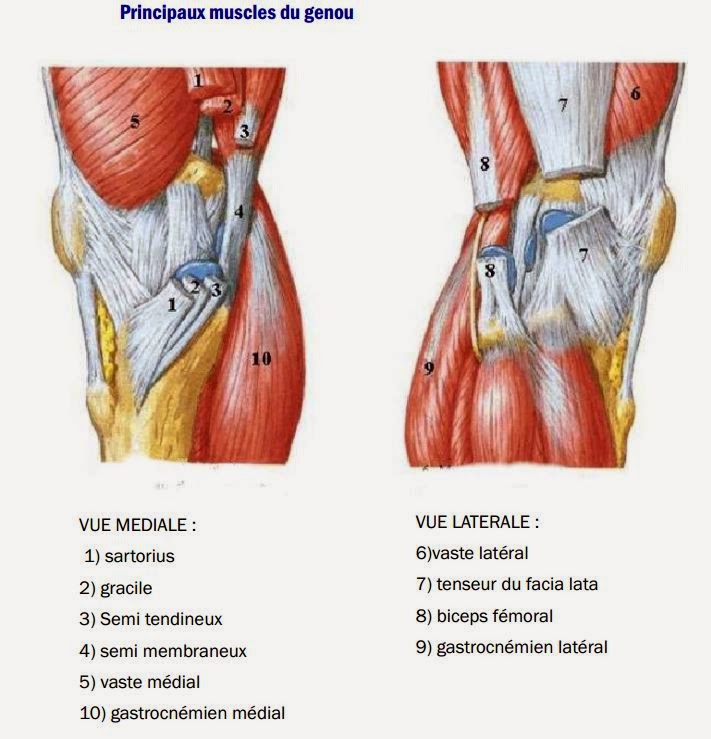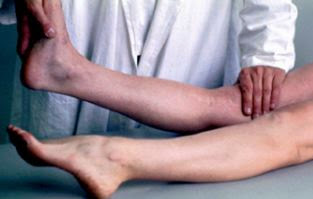It is a classic injury mechanism when playing sports such as football or volleyball. Upon landing a jump, the foot is blocked on the ground in internal rotation, the body pivots in the other direction, which results in internal rotation of the knee putting maximum tension on the anterior cruciate ligament, often beyond the limit of its resistance. This mechanism is often responsible for isolated rupture of the anterior cruciate ligament.
ML in VRI
3- always knee in extension: ML in varus/valgus forced by lateral or medial vulnerating force
These 2 MLs are rare and lead to lesions of the peripheral primary brakes, the external and internal collateral ligaments (LLE and LLI).
 9
9
ML in forced valgus (LLI rupture) and ML in forced varus (LLE rupture)
knee in flexion = multi-ligament sprainIn bending, the situations are completely different.
Flexion lifts the static lock and frees the rotation of the knee, so that external rotation and varus as well as internal rotation and valgus limit each other and lock the knee thanks to the active control of the periarticular musculature which then behaves as a stabilizer dynamic.
Unlike static locking, this dynamic locking has a high damping potential and the peri-articular musculature of the knee has the capacity to damp external traumatic energy by adapting the position of stability according to the direction of the disturbing force, either in valgus - external rotation (VFE), or in varus - internal rotation (VRI).
Maximum positions of stability that can be exceeded by an offensive external forceA bent knee sprain therefore always corresponds to exceeding a position of stability in VRI or VFE and is accompanied by multi-ligament lesions, unlike the isolated lesions of sprains in extension.
1- VFE is the most frequent ML.ML in VFE
- if the vulnerating force in valgus is predominant, there is immediate danger for the LLI, then the PAPI, then the ACL and if the constraint continues, the PCL.
- if the wounding force in RE is predominant, the immediate danger is for the PAPI, then the LLI, then the ACL. If the stress in RE continues, the lesion will extend to the PAPE, while the PCL, serving as a pivot, remains intact.
In VFE, the lesional association LLI + PAPI + ACL is frequent and produces the classic internal lesional triad.
ML in VFE, hemarthrosis in less than 4 hours, internal triad with ecchymosis
2- ML in VRI , there is immediate danger for the PAPE, then the LLE, then due to the excessive screwing of the central ligamentous pivot, the ACL, then the LCP, then the PAPI if the constraint continues.
In VRI, the lesional association PAPE + LLE + ACL = classic external triad. If LCP + PAPE = internal pentad. ML in VRI
Hyper-laxity of the knee
A ligament is an elastic structure, each ligament having a basic laxity and an elongation potential of its own. This baseline laxity is increased bilaterally in hyperlax subjects. Knee joint laxity is therefore a physiological phenomenon and the expression of reciprocal mobility between the femoral and tibial articular surfaces.Conversely, hyperlaxity is a unilateral pathological increase in baseline laxity, a consequence of ligament injury, which can be compensated by other healthy ligament structures, as well as muscle coaptation forces.
For each knee injury, there is therefore a well-defined type of hyper-laxity:
- an isolated lesion of the central pivot leads to pure hyper-laxity with exaggerated but symmetrical displacement of the 2 tibial plateaus forwards if the ACL is torn or backwards if it is the PCL.
- an isolated lesion of the collateral ligaments with an intact pivot leads to internal or external peripheral laxity.
- an associated lesion of the pivot and an internal or external peripheral structure leads to mixed hyper laxity with asymmetrical translation of the tibial plateaus and rotation.
Instability
In the event of a major ligament lesion, the compensation mechanisms are no longer sufficient and the knee joint center (AGC) will be destabilized and knee instability will set in. This instability, unlike hyper-laxity, is always poorly tolerated and clinically manifests as slipping away or feelings of repeated dislocation.
This instability can be present from the outset or occur secondarily, the overload of the remaining healthy ligaments, inducing their progressive distension and by so much ending up altering their stabilizing function.
Unfavorable factors
The prognosis of rotational hyper-laxity due to the greater overload of healthy elements is much worse than that of translational hyper-laxity.
Similarly, external hyper-laxities are less well supported than internal ones given the lesser structural stability of the external compartment.
The genu-varum is also an unfavorable factor, due to its impact on the external ligament structures whose reserves of functional elasticity are diminished.
The genu-recurvatum in the same way distends the posterior capsulo-ligamentous structures as well as the ACL.
Clinical diagnosis of hyper-laxity and instability of knee ligament origin
1- Sagittal hyper-laxity in anterior translation
They are highlighted by the various drawer maneuvers and are positive when there is an abnormal translation of the tibia relative to the femur, either forwards or backwards.
Knee bent at 90°
TAD = direct anterior drawer in neutral rotation, first puts the ACL in tension, then the internal peripheral structures, then the external ones.
TAD (direct anterior drawer)TAD from 3 to 5 mm = isolated ACL.
TAD from 5 to 10 mm = ACL+ LLI or LLE.
TAD > 10 mm = ACL+LLI+PAPI+POPE
TARI = anterior drawer in internal rotation, puts tension on the ACL, then the external structures.
TARI from 5 to 13 mm = isolated ACL.
TARI > 13 mm = ACL + LLE + PAPE
TARE = anterior drawer in external rotation, decreases tension on the ACL and external structures; increases the tension of the internal peripheral structures. A positive TARE = hyper-laxity of the internal compartment: LLI and PAPI.
TARE from 5 to 13 mm = ACL isolated.
TARE from 13 to 19 mm = LLI and PAPI.
TARE > 19 mm = LLI + PAPI + ACL.
Knee flexed at 20° = Lachman-Trillat test
At 20° of flexion, the tensile force of the hamstring muscles which opposes anterior translation is zero, because this force is perpendicular to the anterior drawer, but also because the articular surfaces of the condyles, which are relatively flat, do not interfere more with the movement of the tibial plateaus.
The Lachman test, when it is positive, is very sensitive, even for very low amplitude anterior displacements .
Lachman from 2 to 9 mm = ACL ruptured alone.
Lachman > 10 mm = ACL + peripheral structures.
Lachman-Trillat
2- Posterior hyper-laxity
They are based on the same principle and are carried out using maneuvers this time in the posterior drawer = TP, not always easy to diagnose.TP < 5 mm = possible partial rupture.
TP between 5 and 10 mm = isolated LCP.
TP >10 mm = LCP + PAPE.
Rear drawer (TP)
Three other tests:
1- unilateral recurvatum:small recurvatum = shells medium recurvatum = LCP large recurvatum = LCP + posterior formations and shells.Unilateral recurvatum
2- unilateral external hyper-rotation , stretched knee and bent knee.
3- Godfrey's sign in dorsal decubitus, both knees bent at 90° and heels supported: unilateral recoil of the tibia, signs a rupture of the PCL.
Godfrey's test (tibial metaphysis fall backwards)
3- Lateral hyper-laxity
- knee at 30° flexion, testing in forced varus and valgus:This forced varus-valgus testing at 30° explores the collateral ligaments, while the corner points are relaxed. If the test is positive, this indicates a lesion of the LLE (forced positive varus) or the LLI (forced positive valgus).
- knee in extension, if the varus-valgus test is positive, this indicates a lesion extended to the corner points and even to the central pivot.


varus/valgus testing
4- Dynamic testing of anterior or posterior instabilities.
The instabilities of the knee, whether anterior or posterior, are sought by jump tests.An anterior condylar jump can be looked for in many different ways: Lemaire tests, Mac Intosh, Jerk test, Slocum etc., but the principle is the same: in anterior instability following a rupture of the ACL, the PTE (external tibial plateau) is subluxed forward; if the knee is gradually flexed, towards 30° of flexion, the subluxation is reduced and is accompanied by a jerk perfectly identifiable by the examiner's palpating hand placed at the height of the PTE.
anterior condylar jump
If we take Mac Intosch's Pivot-schift as an example: the start of the test is carried out with the leg stretched, the foot kept in internal rotation by the mobilizing hand, the palpating hand is placed on the external tibial plateau so as to print a slight valgus on the tibia. The knee is gradually flexed and if the knee is stable, the external condyle slides smoothly on the external tibial plateau; in the event of instability, around 30° of flexion, the subluxation of the PTE is suddenly reduced and the palpating hand feels a jump under the fingers. This test is 98% reliable.
Pivot shift and jerk testA positive posterior condylar jump signs the diagnosis of posterior instability and the tests are also very numerous. We will take Jacob's reverse condylar jump as an example: the subject to be examined is in dorsal decubitus, knee bent; by the simple fact of gravity, the PTE sub-luxates backwards, the examiner with his palpating hand, imparts a valgus movement on the PTE, while the distal mobilizing hand, foot positioned in external rotation ,extends gradually the knee and towards 30° of flexion, the subluxation is reduced with a characteristic noise. This test is also 98% reliable.
Jacob's posterior condylar jump
5- Others majors clinical signs in the diagnosis of a sprained knee
- questioning the injured person with analysis of the mechanism of injury (knee stretched, knee bent, anterior, lateral impact), history (often it is the first episode),
- inspection (swelling, bruising in case of capsular breach)
- palpation are also major times.
Among the immediate signs: the perception of a creak contemporaneous with the sports accident (suspicion of lesion of the pivot), the often acute pain in immediate post traumatic, functional impotence (generally it is impossible to get up alone after knee sprain), rapid swelling (in less than 4 hours, hemarthrosis sets in with a sign of the ice cube, but leaves time for the first hour to examine the knee.
Rapid hemarthrosis in less than 4 hours
In the end, if we manage to clinically differentiate the different types of laxity, we can deduce the underlying anatomical lesion, the clinic allowing to strongly suspect the diagnosis at more than 90%.
But there are pitfalls that may prove insurmountable:- the pain can lead to muscle contractures which will make ligament testing impractical or uninterpretable.
- an intra-articular effusion is falsely stabilizing and can mask hyper laxity.
- the morphotype with large legs complicates the physical examination.
- the incompliance (non-cooperation) of certain subjects is often prohibitive.
X-rays must be systematically requested immediately after trauma.
The clinical evaluation must be repeated on the 3rd day; if it is not conclusive and if the examination difficulties remain, recourse to MRI is then desirable.




















































